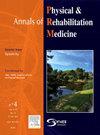Effect of different forms of upper limb muscle training on dyspnea in chronic obstructive pulmonary disease: a randomised controlled trial
IF 4.6
3区 医学
Q1 REHABILITATION
Annals of Physical and Rehabilitation Medicine
Pub Date : 2025-09-17
DOI:10.1016/j.rehab.2025.102021
引用次数: 0
Abstract
Introduction
Patients with chronic obstructive pulmonary disease (COPD) often report an increase in dyspnea during activities involving the upper limbs. For this reason, pulmonary rehabilitation guidelines recommend upper limb training for these patients. However, the most effective training methods are unclear.
Objective
This study aimed to assess the relative effectiveness of upper limb endurance training vs force training in patients with COPD during pulmonary rehabilitation.
Methods
In a randomised, open-label, monocentric controlled trial, the included patients were allocated to either upper limb force training (Force group) or endurance training (Endurance group). Evaluations were performed at baseline and after 4 weeks. The primary outcome was dyspnea, measured using the London Chest Activity of Daily Living questionnaire. Secondary outcomes included dyspnea, assessed using the MMRC Dyspnea Scale and Dyspnea-12 questionnaire; upper limb exercise capacity, measured using the 6-min peg board and ring test; maximal voluntary strength of the deltoid, biceps, and triceps brachii; quality of life, anxiety, and depression. All analyses were performed on an intention-to-treat basis.
Results
280 patients (FEV1[%]: force group: 45.9[19.2]; endurance group: 46.0[17.7]) were included. Dyspnea decreased in both groups. There was no difference in the improvement in dyspnea between both groups, and the minimum important difference of −3 points was not within the 95 % confidence interval (95% CI, −1.0 to 2.1). A significantly greater increase in biceps strength was found in the force group, N.m, 3.3 (6.3) vs 1.5 (6.2), (95% CI, 0.3 - 3.4), P < 0.017. A higher proportion of patients in the force group were unable to reach the required intensity because they found the program too difficult.
Conclusion
We found no significant difference between upper limb force training and upper limb endurance training in terms of changes in dyspnea, arm exercise capacity, quality of life, anxiety, or depression. We therefore suggest incorporating upper limb endurance training during pulmonary rehabilitation.
Trial registration
ClinicalTrials.gov (NCT03611036).
不同形式的上肢肌肉训练对慢性阻塞性肺疾病患者呼吸困难的影响:一项随机对照试验
慢性阻塞性肺疾病(COPD)患者经常报告在上肢活动时呼吸困难增加。因此,肺康复指南建议对这些患者进行上肢训练。然而,最有效的训练方法尚不清楚。目的:本研究旨在评估上肢耐力训练与力量训练在COPD患者肺康复中的相对有效性。方法:在一项随机、开放标签、单中心对照试验中,纳入的患者被分配到上肢力量训练组(force组)或耐力训练组(endurance组)。在基线和4周后进行评估。主要终点是呼吸困难,使用伦敦日常生活胸活动问卷进行测量。次要结局包括呼吸困难,使用MMRC呼吸困难量表和呼吸困难-12问卷进行评估;上肢运动能力,采用6分钟钉板和环试验测量;三角肌、肱二头肌和肱三头肌的最大自主力量;生活质量,焦虑和抑郁。所有分析均以意向治疗为基础进行。结果:共纳入280例患者(FEV1[%]:用力组:45.9[19.2];耐力组:46.0[17.7])。两组呼吸困难均减轻。两组间呼吸困难的改善无差异,最小重要差异-3点不在95%置信区间内(95% CI, -1.0至2.1)。力量组肱二头肌力量明显增加,N.m, 3.3 (6.3) vs 1.5 (6.2), (95% CI, 0.3 - 3.4), P < 0.017。在强迫组中,更高比例的患者无法达到所需的强度,因为他们觉得这个项目太难了。结论:我们发现上肢力量训练和上肢耐力训练在呼吸困难、手臂运动能力、生活质量、焦虑或抑郁方面的变化无显著差异。因此,我们建议在肺康复过程中加入上肢耐力训练。试验注册:ClinicalTrials.gov (NCT03611036)。
本文章由计算机程序翻译,如有差异,请以英文原文为准。
求助全文
约1分钟内获得全文
求助全文
来源期刊

Annals of Physical and Rehabilitation Medicine
Medicine-Rehabilitation
CiteScore
7.80
自引率
4.30%
发文量
136
审稿时长
34 days
期刊介绍:
Annals of Physical and Rehabilitation Medicine covers all areas of Rehabilitation and Physical Medicine; such as: methods of evaluation of motor, sensory, cognitive and visceral impairments; acute and chronic musculoskeletal disorders and pain; disabilities in adult and children ; processes of rehabilitation in orthopaedic, rhumatological, neurological, cardiovascular, pulmonary and urological diseases.
 求助内容:
求助内容: 应助结果提醒方式:
应助结果提醒方式:


